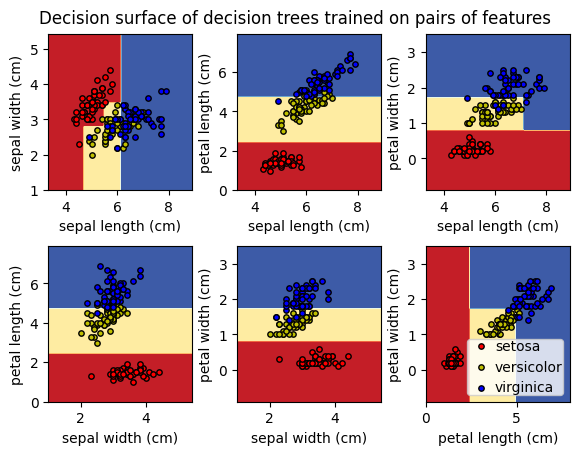Workflow in Action
Workflow in Action¶
In this we will translate the six-step theoretical workflow into a practical, end-to-end coding exercise. You will train, predict with, and evaluate your first machine learning model using a Iris dataset, a classic toy dataset tht's very useful for learning various topics in machine learning.
Objective: Apply the complete modeling workflow to the Iris dataset using scikit-learn and develop familiarity with scikit-learn's estimator API.
Setup: Importing Libraries¶
First, we import the necessary libraries. We need Polars for data handling and various modules from scikit-learn for loading the dataset, splitting the data, instantiating the model, and evaluating its performance.
import polars as pl
from sklearn.datasets import load_iris
from sklearn.model_selection import train_test_split
from sklearn.tree import DecisionTreeClassifier
from sklearn.metrics import accuracy_score
# For the bonus visualization
import matplotlib.pyplot as plt
from sklearn.tree import plot_tree
Step 1: Load & Prepare Data¶
We will use the classic Iris dataset, which is conveniently included with scikit-learn. Our first action is to load the data and convert it into a Polars DataFrame, which allows for easier inspection and manipulation. We then separate our features (X) from our target (y).
# Load the dataset from scikit-learn
iris_data = load_iris()
# Create a Polars DataFrame
# The data is in '.data' and column names in '.feature_names'
df = pl.DataFrame(
data=iris_data.data,
schema=iris_data.feature_names
).with_columns(
# Add the target variable, which is in '.target'
pl.Series(name="target", values=iris_data.target)
)
# Define our features (X) and target (y)
X = df.select(pl.exclude("target"))
y = df.select("target")
# Display the first 5 rows of the feature DataFrame
print("Features (X):")
print(X.head())
# Display the first 5 rows of the target DataFrame
print("\nTarget (y):")
print(y.head())
Step 2: Split the Data¶
Next, we partition the data into training and testing sets. This is a critical step to ensure an unbiased evaluation of our model. We will allocate 30% of the data for the test set and set a random_state to ensure that our split is reproducible every time the code is run.
X_train, X_test, y_train, y_test = train_test_split(
X, y, test_size=0.3, random_state=42
)
# Verify the dimensions of the resulting datasets
print(f"Shape of X_train: {X_train.shape}")
print(f"Shape of X_test: {X_test.shape}")
X_train has 105 rows and X_test has 45 rows, corresponding to a 70/30 split of the original 150 rows.
Step 3: Instantiate the Model¶
We will now instantiate our DecisionTreeClassifier. To prevent the model from becoming overly complex, we will set the max_depth hyperparameter to 3. We also pass the random_state for reproducibility of the model's training process.
Step 4: Train the Model¶
With our model instance created and our training data ready, we can execute the training step. We use the .fit() method on our training data (X_train and y_train).
model object is no longer an empty shell; it now contains the learned rules (parameters) from the Iris training data.
Step 5: Generate Predictions¶
Our model is now trained. We can use the .predict() method to generate predictions on the unseen data we held back in our test set (X_test).
# Generate predictions for the test set
predictions = model.predict(X_test)
# Display the first 10 predictions
print(predictions[:10])
Step 6: Evaluate Model Performance¶
This is the final step where we quantify the model's performance. We compare the predictions our model made against the actual ground truth labels in y_test using the accuracy_score metric.
# Calculate the accuracy of the model
accuracy = accuracy_score(y_test, predictions)
print(f"Model Accuracy on Test Set: {accuracy:.4f}")
Visualizing the Model's Logic¶
A key advantage of the Decision Tree is its interpretability. We can visualize the rules the model learned during the .fit() step to understand exactly how it is making decisions.
# Set the figure size for better readability
plt.figure(figsize=(20, 10))
# Create the plot
plot_tree(
model,
feature_names=X.columns,
class_names=iris_data.target_names,
filled=True,
rounded=True
)
# Display the plot
plt.show()

We can also visually explore to understand how different features contribute to how model performs and identify opportunities to simplify the model in the next iteration.
iris = load_iris()
# Parameters
n_classes = 3
plot_colors = "ryb"
plot_step = 0.02
for pairidx, pair in enumerate([[0, 1], [0, 2], [0, 3], [1, 2], [1, 3], [2, 3]]):
# We only take the two corresponding features
X = iris.data[:, pair]
y = iris.target
class_names = iris.target_names
# Train
clf = tree.DecisionTreeClassifier(max_depth=3, random_state=42).fit(X, y)
# Plot the decision boundary
ax = plt.subplot(2, 3, pairidx + 1)
plt.tight_layout(h_pad=0.5, w_pad=0.5, pad=2.5)
DecisionBoundaryDisplay.from_estimator(
clf,
X,
cmap=plt.cm.RdYlBu,
response_method="predict",
ax=ax,
xlabel=iris.feature_names[pair[0]],
ylabel=iris.feature_names[pair[1]],
)
# Plot the training points
for i, color in zip(range(n_classes), plot_colors):
idx = np.asarray(y == i).nonzero()
plt.scatter(
X[idx, 0],
X[idx, 1],
c=color,
label=iris.target_names[i],
edgecolor="black",
s=15,
)
plt.suptitle("Decision surface of decision trees trained on pairs of features")
plt.legend(loc="lower right", borderpad=0, handletextpad=0)
_ = plt.axis("tight")
